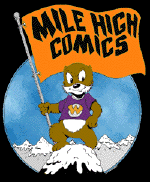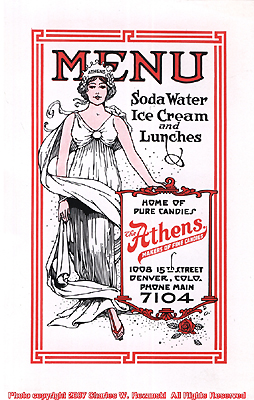Revisiting Edgar Church
as an Artist
|
I wanted to share a new insight with you today as regards Edgar Church, the gentleman who accumulated the fantastic hoard of Golden Age comics that has come to be known as the "Mile High" collection. I'm not going to retell the entire story (originally published 3 years ago in CBG) of my having rescued Mr. Church's collection from being tossed into the landfill, as that 17-installment story is simply takes too long. I did want to spend a little time writing about Mr. Church as an artist, however, as I think that I may finally have figured out at least a part of his fascination with comics.
Where this all ties in with comics, is that Mr. Church was an avid borrower of visual cues from all media. Because of the unique nature of my rescue of his comics, it was regrettably necessary that I let a huge quantity of Mr. Church's personal clip file be thrown away. As a result, I have no idea of just how many individual pieces of clip art that he had cut out during his career. I can tell you, however, that just the clip art boxes that I managed to save filled an entire van to the ceiling. Those clippings ranged from full color Maxfield Parrish ads, to entire pulp magazine covers, to clippings of ordinary ads from newspapers. Clearly, Mr. Church spent many thousands of hours building his vast clip files over a period of more than half a century. Without a doubt, tens of thousands of magazines and newspapers were cut up in order to satisfy his voracious appetite for visual cues from which to create his own artwork. To this point, my story could be one about any number of artists working during the first half of the 20th century, as clip art DVD's were clearly unavailable during those pre-computer years, so all artists needed their own personal reference library of images from which to work. Where this story diverges from most, however, is that Mr. Church not only purchased massive numbers of comics for their imagery, but also kept them in their entirety. Until quite recently, I was of the belief that Mr. Church kept his comics because he so desperately wanted to be a comics artist. If you look at the additional Edgar Church artwork I have archived on the Mile High Comics homepage (the link is midway down), you will see several pages of the artwork from THE GREEN COBRA, a character that Mr. Church tried, to no avail, to sell to the New York publishers. It wasn't a particularly great comic book, but on the other hand, it wasn't any worse than quite a few that ultimately saw print during the Golden Age. The problem Mr. Church had with selling his strip was that he didn't live in New York. With hundreds of starving artists living darn near on their doorsteps, there was simply no way that a New York publisher was going to go through the hassles of having artwork created 2,000 miles away. So after spending his entire savings on one futile trip to Manhattan in 1940, Mr. Church finally gave up on his dream of becoming a professional comics creator. So, why in the heck did he not only keep all of his comics, but also spend vast sums (probably every cent that he was making freelancing at night...) on even more comics? It boggles the mind to realize that he loved comics so much that he purchased every single action, adventure, and super-hero title published between 1938-1953, as well as quite a few humor titles! His addiction to comics was so great that he actually had comics set aside for him at a local newsstand each week. That's why so many of the books in the "Mile High" collection ended up in such excellent condition. You have to ask yourself if Mr. Church set up the very first comics "hold" box ever created? Whatever the case, he was such a good customer that the otherwise pristine ACTION COMICS #1 even had his name, "Church," very neatly penciled in tiny type at the top of the cover by the newsstand staff. That is just so amazingly cool! In the end, however, fervently wanting to be a comics creator doesn't logically explain why he kept at such an expensive endeavor long after his dreams died. This has been a conundrum for me for the past 30 years, and I've never really stopped thinking about it. The answer came to me just last week, as I was working on archiving and protecting a stash of approximately 2,000 pieces of clip art that he saved of his own works. While placing some local newspaper ads into a folder, I suddenly had the epiphany that the ad that I was holding in my hand contained nearly the exact same lettering font as the title font used for the 1941 HEROIC COMICS (title font created by Bill Everitt). That realization made me suddenly see comics from an entirely different perspective. Yes, Edgar Church wanted to be a comics artist. But while that particular dream never came to fruition, comics still served an incredibly useful purpose for him, as they are overflowing with remarkably creative and distinctive lettering. Take a moment to look at comics through Edgar Church's eyes, and it quickly becomes evident that the comics of the 1940's are a cornucopia of lettering inspiration. It may well be true that no other single medium ever inspired artists to design so many different hand drawn types and fonts. Given that Mr. Church was being faced with creative challenges to come up with fresh "looks" every day at both his day job with the phone company, and his nighttime freelance work, doesn't it make sense that having a weekly flow of new inspiration could be incredibly valuable to him? That may also explain why his comics purchasing stopped (except for purchasing through second hand stores) in 1953, when he retired from the phone company. I had always thought that he stopped because his income dropped when he retired, but what if he simply didn't need the new inspirations any more? I could most certainly be wrong, but this new theory of mine ties up some otherwise loose ends. In the interests of brevity, I will end this column at this point. If you would like to read more about Edgar Church, the entire 17-chapter story is available via the Tales From the Database link on the MileHighComics.com home page. In closing, however, I would like to note that the 30th anniversary of my having rescued Mr. Church's comics was just last week. I took a moment on Thursday and drove down the street where he lived, and gave my silent thanks to him for all he has done for me, my family, and the world of comics. I also promised him that I would do everything in my power to make certain that his genius will never be forgotten. This column is but one way of keeping that promise...
Please send your e-mails to chuck@milehighcomics.com, and your letters to:
Mile High Comics, Inc.
|
| Previous | Next |


